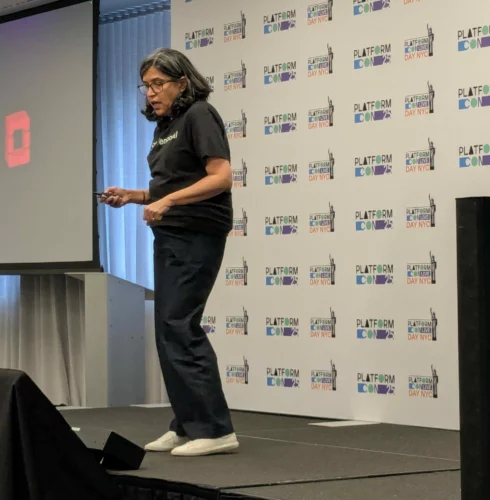
Platform engineering can be a valuable asset to an organization, but there are a number of strategies teams need to implement in order to drive success.
In a talk at PlatformCon 2025 in NYC last week, Preeti Somal, senior VP of engineering at Temporal, gave a talk about the human side of platform engineering. She gave seven strategies to follow to ensure that platform teams aren’t overlooking this crucial piece of the puzzle.
-
Have a clear mission
According to Somal, Temporal’s mission is to build developer-friendly tools that are reliable. Its logo resembles a shield and its mascot is a tardigrade, a creature known for being pretty much indestructible. They can survive in extreme temperatures and pressures, and can withstand air deprivation, radiation, dehydration, and starvation.
In fact, the company sent a plushie of their mascot into space along with a Raspberry Pi just to prove how resilient it is. “We were running workflows, and of course, at some point the Raspberry Pi lost connectivity, and then you could see that as the machine was coming back into orbit and picked up connectivity, the workflow picked up from exactly where it had dropped off and started executing.”
The moral of the story is to live your company’s mission in everything you do, even down to the company branding.
- Make it easy to get started
“Make it so simple to use that it’s a no-brainer and everybody in the engineering organization starts using it,” she said.
She said she learned this lesson during her time at Yahoo, which was a big OpenStack shop. One of the things that her team did was build a solution that allowed engineers at the company to request virtual machines, no questions asked.
That made it so easy for people to get started, which really helped platform adoption, and things just snowballed from there, Somal said.
-
Find your customers and bootstrap with them
She said that it’s important to find the groups that benefit from the platform you’re building and work closely together. Temporal, for example, brings in its community on a regular basis to talk about what they’re building.
Another example Somal shared was that when she was at Yahoo, her team spent about six to eight months building a platform as a service project using Mesosphere. Meanwhile, another team in another group was building with a new technology called Kubernetes.
“We had our blinders on and were like, ‘we spent eight months doing this, and Kubernetes is just so complicated. It’s not going to happen.’ Of course, that was a huge mistake. We should have partnered with the team that was actually going to use this platform and built this thing together. We should have looked at that together.”
She said a key part of this strategy is also to get early wins, otherwise it’s easy for projects to linger and die a slow death.
-
Talk about it
The same principals of dev rel around products also matter with platforms. Even though with platforms your customers are other employees within the organization, you still need to promote it in order for your platform to be visible and adopted.
“You think ‘if you build it, they will come.’ Or you’re so involved in building the perfect solution that you’re not talking about it. You need to.”
When Somal was at Yahoo, for example, they put posters in the kitchens and made and distributed t-shirts about the platform they were building to spread awareness around the company.
-
Be reliable
If you want people to actually use the platform, it has to be reliable. Not only does the technology need to be reliable, but the team needs to be reliable and readily available to answer any questions or address concerns.
For instance, she shared that Snap stories use Temporal, and there is a huge spike that occurs every New Years Eve. “We showed up for them. We were in the office. We were with them on a Zoom as New Years kicked in and the spikes started happening,” she said.
If your platform isn’t reliable (and you aren’t reliable), then there are so many other options to choose from, and moving to another platform is really not that hard.
-
Celebrate success often
Somal says that platform engineering teams often operate in a part of the organization that nobody’s really heard of, and are doing their work rather quietly. “When a business unit is successful, we may or may not get a shoutout,” she said.
At Temporal they’ve been practicing celebrating successes even for simple things like reduction in CPU usage. She says that every little thing makes a difference, and recognizing those successes will boost morale.
-
Embrace shifts
And finally, it’s important to not stand still. Technology is constantly evolving, and platform teams should adapt to these changes.
One of the ways Temporal is embracing shifts is to figure out its AI evolution by partnering with early adopters, learning, and iterating.






